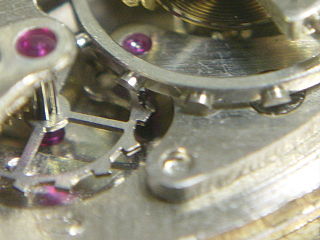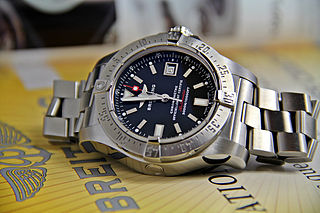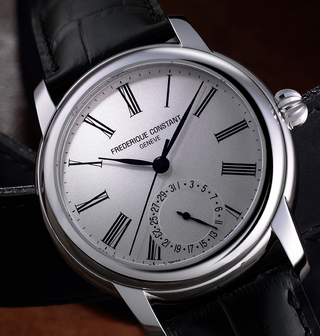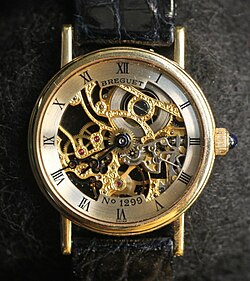
A watch is a portable timepiece intended to be carried or worn by a person. It is designed to keep a consistent movement despite the motions caused by the person's activities. A wristwatch is designed to be worn around the wrist, attached by a watch strap or other type of bracelet, including metal bands, leather straps, or any other kind of bracelet. A pocket watch is designed for a person to carry in a pocket, often attached to a chain.

A pocket watch is a watch that is made to be carried in a pocket, as opposed to a wristwatch, which is strapped to the wrist.

Seiko Group Corporation, commonly known as Seiko, is a Japanese maker of watches, clocks, electronic devices, semiconductors, jewelry, and optical products. Founded in 1881 by Kintarō Hattori in Tokyo, Seiko introduced the world's first commercial quartz wristwatch in 1969.

Zenith SA is a Swiss luxury watchmaker. The company was started in 1865 by Georges Favre-Jacot in Le Locle in the canton of Neuchâtel and is one of the oldest continuously operating watchmakers. Favre-Jacot invented the concept of "in house movements", believing that only through control of the entire watchmaking process could the highest quality be achieved. Zenith was purchased by LVMH in November 1999, becoming one of several brands in its watch and jewelry division, which includes TAG Heuer and Hublot. Benoit de Clerck is the company's current president and CEO.

In horology, a tourbillon is an addition to the mechanics of a watch escapement to increase accuracy. Conceived by the British watchmaker and inventor John Arnold, it was developed by his friend the Swiss-French watchmaker Abraham-Louis Breguet and patented by Breguet on 26 June 1801. In a tourbillon the escapement and balance wheel are mounted in a rotating cage, with the goal of eliminating errors of poise in the balance giving a uniform weight.

In horology, a complication is any feature of a timepiece beyond the display of hours, minutes and seconds. A timepiece indicating only hours, minutes and seconds is known as a simple movement. Common complications include date or day-of-the-week indicators, alarms, chronographs (stopwatches), and automatic winding mechanisms. Complications may be found in any clock, but they are most notable in mechanical watches where the small size makes them difficult to design and assemble. A typical date-display chronograph may have up to 250 parts, while a particularly complex watch may have a thousand or more parts. Watches with several complications are referred to as grandes complications.

A Roskopf, pin-lever, or pin-pallet escapement is an inexpensive, less accurate version of the lever escapement, used in mechanical alarm clocks, kitchen timers, mantel clocks and, until the 1970s, cheap watches now known as pin lever watches. It was popularized by German watchmaker Georges Frederic Roskopf in its "proletarian watch" from 1867. It was invented in 1798 by Louis Perron, of Besançon, and suggested to Roskopf by Jules Grossmann.
Movado is an American watch brand originally founded in 1881 in Switzerland. Movado means "movement" in Esperanto. The watches are known for their signature metallic dot at 12 o'clock and minimalist style; the company is best known for its Museum Watch.

Audemars Piguet Holding SA is a Swiss manufacturer of luxury watches, headquartered in Le Brassus, Switzerland. The company was founded by Jules Louis Audemars and Edward Auguste Piguet in the Vallée de Joux in 1875, acquiring the name Audemars Piguet & Cie in 1881. The company has been family-owned since its founding.

The history of watches began in 16th-century Europe, where watches evolved from portable spring-driven clocks, which first appeared in the 15th century.

George Daniels, CBE, FBHI, FSA, AHCI was an English horologist who was considered by some to be one of the best in the world in the field of luxury mechanical watches and timepieces during his lifetime. He was a watchmaker who all but completely built 23 pocket watches and 2 wrist watches as well as a number of clocks all by hand. Daniels commented often that "a watch has historic, intellectual, technical, aesthetic, useful and amusing qualities" and he sought to make watches that did each of these things while consistently improving on the technical and horological aspects of each watch he made. As at December 2022, George Daniels watches only sat behind Patek and Rolex watches by reference to value and number of watches sold, with 6 watches achieving prices in excess of USD$1.5 million. This makes George Daniels watches the first independently made watches to achieve this result.

An automatic watch, also known as a self-winding watch or simply an automatic, is a mechanical watch where the natural motion of the wearer provides energy to wind the mainspring, making manual winding unnecessary if worn enough. It is distinguished from a manual watch in that a manual watch must have its mainspring wound by hand at regular intervals.

A diving watch, also commonly referred to as a diver's or dive watch, is a watch designed for underwater diving that features, as a minimum, a water resistance greater than 1.1 MPa (11 atm), the equivalent of 100 m (330 ft). The typical diver's watch will have a water resistance of around 200 to 300 m, though modern technology allows the creation of diving watches that can go much deeper. A true contemporary diver's watch is in accordance with the ISO 6425 standard, which defines test standards and features for watches suitable for diving with underwater breathing apparatus in depths of 100 m (330 ft) or more. Watches conforming to ISO 6425 are marked with the word DIVER'S to distinguish ISO 6425 conformant diving watches from watches that might not be suitable for actual scuba diving.

A mechanical watch is a watch that uses a clockwork mechanism to measure the passage of time, as opposed to quartz watches which function using the vibration modes of a piezoelectric quartz tuning fork, or radio watches, which are quartz watches synchronized to an atomic clock via radio waves. A mechanical watch is driven by a mainspring which must be wound either periodically by hand or via a self-winding mechanism. Its force is transmitted through a series of gears to power the balance wheel, a weighted wheel which oscillates back and forth at a constant rate. A device called an escapement releases the watch's wheels to move forward a small amount with each swing of the balance wheel, moving the watch's hands forward at a constant rate. The escapement is what makes the 'ticking' sound which is heard in an operating mechanical watch. Mechanical watches evolved in Europe in the 17th century from spring powered clocks, which appeared in the 15th century.

Frédérique Constant SA is a Swiss manufacture of luxury wristwatches based in Plan-les-Ouates, Geneva. Originally established in 1988 by Dutch married couple Peter Stas and Aletta Stas-Bax, it was acquired in 2016 by Citizen Holdings of Tokyo, Japan.

A counterfeit watch is an unauthorised copy of an authentic watch. High-end luxury watches such as Rolex, Patek Philippe and Richard Mille are frequently counterfeited and sold on city streets and online. With technological advancements, many non-luxury and inexpensive quartz watches are also commonly counterfeited.

Bovet Fleurier SA is a Swiss brand of luxury watchmakers chartered 1 May 1822 in London, UK by Édouard Bovet. It is most noted for its pocket watches manufactured for the Chinese market in the 19th century. Today it produces high-end artistic watches with a style that references its history.

The trench watch (wristlet) is a type of watch that came into use by the military during World War I, as pocket watches were not practical in combat. It was a transitional design between pocket watches and wristwatches, incorporating features of both.

Jean-Antoine Lépine was a French watchmaker. He contributed inventions which are still used in watchmaking today and was amongst the finest French watchmakers, who were contemporary world leaders in the field.

The Chinese Standard Movement, also commonly known as the "Tongji" movement, is a mechanical watch movement that was developed in the People's Republic of China during its fourth Five-Year Plan in the 1970s. It was designed by engineers from several early Chinese watch factories as part of a Ministry of Light Industry initiative to consolidate the industry, and with a few exceptions it became mandatory for all factories to discontinue the production of their own movements and to mass-produce the standard movement. Because of this, the production of the standard movement defines an entire era in the history of Chinese watchmaking. Once the most commonly produced mechanical/automatic watch movements in China, the numbers produced and their quality have since declined significantly; today the movement lives on typically in simple automatic and skeletonized variants, usually installed in cheaply produced watches made in China as well.




















